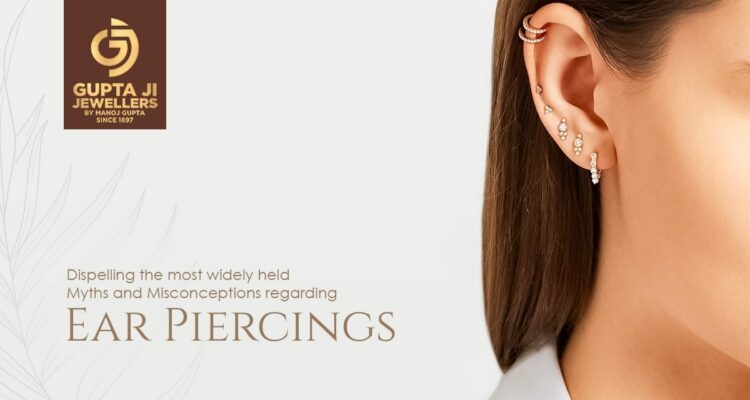Ear piercings have weaved a colorful thread across the rich fabric of human civilization, spanning thousands of years and many societies and traditions.
Despite their long history and universal acceptability, ear piercings are sometimes cloaked in misconceptions and myths which is why today, we hope to dispel these myths by separating facts from fiction and shedding light on the genuine nature of ear piercings.
Misconception #1: Ear Piercings Are Only for Women
One of the most common ear piercings misconceptions is that they are just for women. This could not be further from the truth. Ear piercings have been an element of masculine fashion and culture for ages.
In fact, men from numerous civilizations decorated their ears with precious metals and stones in the past to symbolize rank and riches.
In current times, men’s ear piercings have been accepted as a form of self-expression and flair, breaking gender conventions and social expectations.
Misconception #2: Ear Piercings Are Really Painful
The notion of a needle entering through the skin can be unnerving, and many people connect ear piercings with severe pain. However, this is a major exaggeration.
The degree of pain felt during an ear piercing varies from person to person, but it is typically characterized as a fast, acute squeeze followed by slight soreness.
The discomfort is brief, and many people find it less painful than a standard injection. Professional piercers also employ techniques and equipment that reduce discomfort, resulting in a smoother and more pleasurable experience.
Misconception #3: It’s Easy for Ear Piercings to Get Infected
Another prevalent misunderstanding is that ear piercings are more prone to infection. While any tear of the skin might result in an infection, appropriate aftercare significantly minimizes this risk.
Professional piercers give extensive aftercare advice that, when followed properly, reduces the risk of infection. Regular saline solution washing, as well as avoiding unwanted touching or twisting of the piercing, can help promote proper healing.
It’s also important to be pierced with sterilized tools in a clean setting, which reduces the chance of infection.
Misconception #4: It Takes a Long Time for Ear Piercings to Heal
The healing period for ear piercings varies depending on the location of the piercing and the person’s healing process. However, the idea that ear piercings take an extremely lengthy time to recover is incorrect.
Most earlobe piercings heal in 4-6 weeks, whereas cartilage piercings may take longer, ranging from 4 months to a year. During this period, the body heals and naturally accepts the piercing.
Following the piercer’s aftercare instructions is crucial, and avoiding the impulse to replace or remove the jewelry too soon guarantees good healing.
Misconception #5: Ear Piercings Generally Leave Permanent Holes
Many individuals assume that once your ears are pierced, the holes remain forever.
While piercings are a kind of bodily alteration, the body’s ability to heal and adapt means that many piercings may close if the jewelry is removed and kept out for an extended length of time, particularly if the piercing is fresh.
The durability of a piercing hole is mostly determined by how long it has been in place and how your body recovers. Some may develop permanent holes, while others may discover that their piercings seal up quickly.
Misconception #6: You Cannot Get an MRI with Ear Piercings
The belief that you can’t have an MRI if you have ear piercings derives from worries about metal and magnetic fields. However, this is usually not a problem.
Most piercing jewelry is composed of non-magnetic materials like titanium, surgical steel, or gold. It is usually suggested that you contact your healthcare practitioner about your piercings so that they may advise on whether the jewelry should be removed.
In most circumstances, it is unneeded; but if removal is unavoidable, temporary nonmetallic jewelry can keep the piercing open.
Misconception #7: Ear Piercings are Uncivil
The idea that ear piercings are unprofessional and uncivil is a rapidly evolving misconception.
Piercings’ acceptance varies greatly between cultures, sectors, and corporations. In artistic areas, fashion, and even many business environments, ear piercings are commonly encouraged as a form of self-expression.
And, as society advances, the notion of professionalism evolves, becoming more open to personal expression.
Final Thoughts
Ear piercings are a form of self-expression with historical and cultural importance. By dispelling these popular ear piercings misconceptions, we may recognize ear piercings for what they are – a personal choice that represents individual style and cultural heritage, transcending age, gender, and race.
Whether you choose to get your ears pierced or appreciate them on others, knowing the facts promotes an environment of acceptance and respect for this age-old practice.
If you or any of your loved ones are looking to get your ears pierced without having to deal with the notion that ear piercing is painful then make sure to visit Gupta Ji Jewellers.
Gupta Ji Jewellers is the perfect match for your ear-piercing needs.

